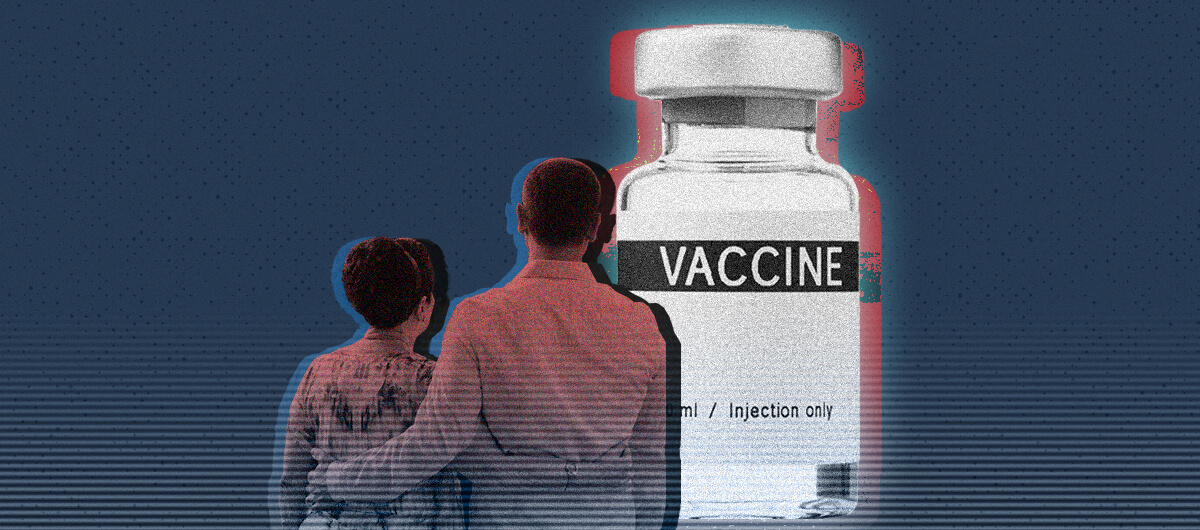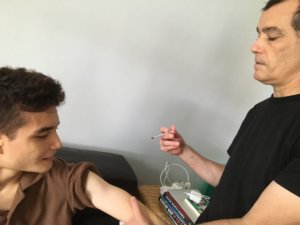

disability rights
Are We Vaccinating Our Most At-Risk Communities?
Disabled people are entitled to at-home vaccinations. But the author discovered it's easier said than done as she tried to schedule an appointment for her 21-year-old son who has autism and developmental disabilities.
This article was made possible because of the generous support of DAME members. We urgently need your help to keep publishing. Will you contribute just $5 a month to support our journalism?
President Biden proposed that local communities go “door-to-door” to bring the COVID-19 vaccines to the remaining unvaccinated. Not surprisingly, his proposal received immediate Republican pushback claiming government overreach. But one of the fiercest rebukes came from Rep. Madison Cawthorn (NC-11), a wheelchair-bound, reactionary congressman, who warned, “They could then go door-to-door and take your guns. They could go door-to-door and take your Bibles.”
For more than a year, we’ve been cooped up in a New York City apartment with our 21-year-old son who has autism and intellectual disability. I would gladly give up “my guns and Bibles” for someone to bring a vaccine to our home. The COVID-19 vaccine held so much promise for ushering in an end to the pandemic. It was exciting, even beautiful to behold the sight of the elderly and frontline workers receiving their vaccines, to see socially distanced lines previously used for voting, forming again, this time to be inoculated against a virus that brought the world to its knees and took millions of lives around the world. In New York City, friends were vaccinated under the iconic whale in the Museum of Natural History. My spouse rode his bike down to the cavernous Javits Convention Center, where he was amazed at the efficiency of the system.
However, the group of people who may be at the highest risk for dying of COVID-related complications, according to an insurance-industry study, are people with intellectual disabilities—and they have been, inexplicably, the most overlooked by the CDC and state and local governments. The American Network of Community Options & Resources (ANCOR), a nonprofit advocacy group for people with disabilities wrote to each of the nation’s governors urging them to prioritize people with developmental disabilities. But as of March 2021, when the rollout was well underway, only 32 states had any kind of accounting for this population, including Alabama, where “people with disabilities listed at the bottom.”
New York State does list developmental/intellectual disability as an official COVID-19 comorbidity, but, like most things, actually following through to accommodate the disabled is little more than an afterthought.
The way mass vaccination is set up, even the lockstep efficiency of the gigantic Javits Center, involves waiting in line, rolling up your sleeve, and receiving a vaccine. But our son, J, would not be able to endure the line. Just the sight of a needle would set him off screaming and he’d run away. J, who also has difficulty following instructions, becomes anxious around strangers, especially in crowds. I have my phone set up for various alerts, and when I learned that an in-home vaccination was being offered for people with disabilities, I immediately signed J up via their website. We were to expect a callback to make an appointment in “up to a few weeks.”
In the meantime, as we prepared J for what vaccination would be like to defuse his anxiety, we communicated with him in ways he understood about his feelings about getting the shot. Now that J is an adult, I regret letting busy doctors’ offices dictate how procedures are done on him—and, I suspect, on other people with intellectual disabilities—generally coercing the patients, giving them little explanation or patience for that matter. This time, I wanted J to have as much agency as possible in this process, including not having other people hold him down. Studies have shown that the fear of pain can make it worse. So we asked J if he wanted to get vaccinated against “the virus”—he consistently responded “yes.”
I’d already started him on a do-it-yourself desensitization program for blood draws, which has involved me learning phlebotomy. He often becomes so tense during blood draws, with adults holding him down, that his veins collapse. The stress hormones actually affect the reading and so it has to be redone multiple times. Neurotypical coping strategies such as distraction and looking away are lost on him. With his sensory issues, even such preliminary movements such as pushing up a sleeve and rubbing on the alcohol set up a reaction where he does not want anyone to touch him. I hoped that by familiarizing him with the steps and having me draw the blood in a familiar setting, he could understand that it would “pinch,” and that sitting still would lessen the pain. Prepping for the vaccine in the home setting would be an extension of that. We practiced the motions with a syringe without a needle.
Three weeks passed, then a month. Vaccination rates in New York City dropped precipitously in the summer even as the highly transmissible Delta variant became more dominant. Still no callback to schedule an appointment. Calls to the agency only connected me with apologetic clerks who had no information but thanked me for not yelling at them, as other frustrated callers had. The clerks had no more information than I did—J’s appointment just to make an appointment was in limbo and might not even exist.
This kind of frustration is not new to me, having to make our own accommodations in a system that puts the right words on a website but little else. I try to think what it would be like if I didn’t speak English well, if I had a job that wouldn’t allow me to call the agency in the middle of the day; as a writer and a college lecturer, I have plenty of time during the summer to practice the shot with J.

It happened to be time for my second Pfizer shot at our local pharmacy, which is generally underpopulated. Other pharmacies had lines, people getting vaccines out in the open, crowded next to people in line to pick up their prescriptions. This particular local chain also had a vaccination setup with a private room in the back. I asked the pharmacist if J could accompany me into the room. With his permission, J got to watch as my husband and I narrated how important it was to “stay still.” J understands sequences, so in our practice at home, it soon became: “Stay still, get shot, get treat.”
As with the phlebotomy training, it became clear to me that J has to experience some reality of what a needle stick feels like in a clinical setting so he wouldn’t feel like we tricked him. I have a wonderful friend who keeps us supplied with various medical needles, and my husband and I first showed him how to “stay still” as we ceremoniously stuck each other.
I continued to call the hotline and the cheerful clerks told me they had no idea what the timeline was, if J was even signed up. They were just there to take calls. Every time I’d try to place him on the list again by talking to a real person, the site was down and I was told to call back again and again. I even tweeted my frustration at city-council members, even the Manhattan Borough President—but to no avail. Given the public laments by officials about stagnating vaccination rates, the delay seemed strange. It was impossible to tell if the non-reply from the city was due to high demand for the program, or if J’s place in line was just in limbo through some software failure. By then I would have invited Rep. Cawthorn into the apartment if that would have speeded things up.
In the abstract, people like to think they care for the most vulnerable in our society, people with disabilities. Unfortunately, most resemble Alabama, whose only mention of the disabled is a deliberate afterthought in its COVID planning. When our son was a toddler, he was in a body cast and needed a heavy wheelchair, and I soon learned how unusable sidewalks were for the disabled—cars and debris obstructing us with impunity but also in many places (in Rhode Island and California), the cutouts in the curbs expressly made for wheeled things often were nonexistent or too steeply cut, restricting many of our walks, or necessitating that we pack up the giant chair and drive someplace.
Similarly, we’ve had to steer around all the obstacles presented to us. Formally giving up on the in-home program, we made an appointment at the pharmacy. When the day came, we made sure J was hydrated and fed, and walked down to the place. In the week leading up to his appointment, we’d made sure to walk in and out of the pharmacy just to familiarize J with it. When we arrived in the middle of the morning, as usual, the place was empty. The pharmacist on duty was a different person than the one who’d let J watch earlier, but he seemed unfazed to learn about J’s disabilities. We sat J down, got him ready, and he jerked away, talking about being hurt; he anxiously guarded his arm with his free hand.
“You can’t do that, Buddy,” the pharmacist said, a little crankily. “You’re not sterile now, I have to put the alcohol on again.”
Dad took his hand lightly for comfort. If J jerked away again, he’d probably set a pattern that would be hard to break. The pharmacist reapplied the alcohol, and then with admirable speed, administered the shot. Most people turn away, but J looked. He saw the needle go in. He stayed still. He was proud. We were proud.
We have to wait three more weeks for the second shot. We feel confident he will do okay. If he doesn’t, we will have to adapt.
However, with the threat of highly transmissible variants, with more than 600,000 Americans already dead of COVID, and a population that doesn’t always have the luxury of the time and wherewithal to run a desensitization program at home, how many others are sitting at home, increasingly isolated, increasingly vulnerable in a country where we have so many vaccines we will be throwing them out soon?
In an interview with the New York Times, Krystal Bailey, a vocational rehabilitation counselor with the New York State Education Department said, “I don’t think our society is more open to people with disabilities now, I think we’re just more in your face.” We are still waiting for our callback.
Before you go, we hope you’ll consider supporting DAME’s journalism.
Today, just tiny number of corporations and billionaire owners are in control the news we watch and read. That influence shapes our culture and our understanding of the world. But at DAME, we serve as a counterbalance by doing things differently. We’re reader funded, which means our only agenda is to serve our readers. No both sides, no false equivalencies, no billionaire interests. Just our mission to publish the information and reporting that help you navigate the most complex issues we face.
But to keep publishing, stay independent and paywall free for all, we urgently need more support. During our Spring Membership drive, we hope you’ll join the community helping to build a more equitable media landscape with a monthly membership of just $5.00 per month or one-time gift in any amount.
















































































